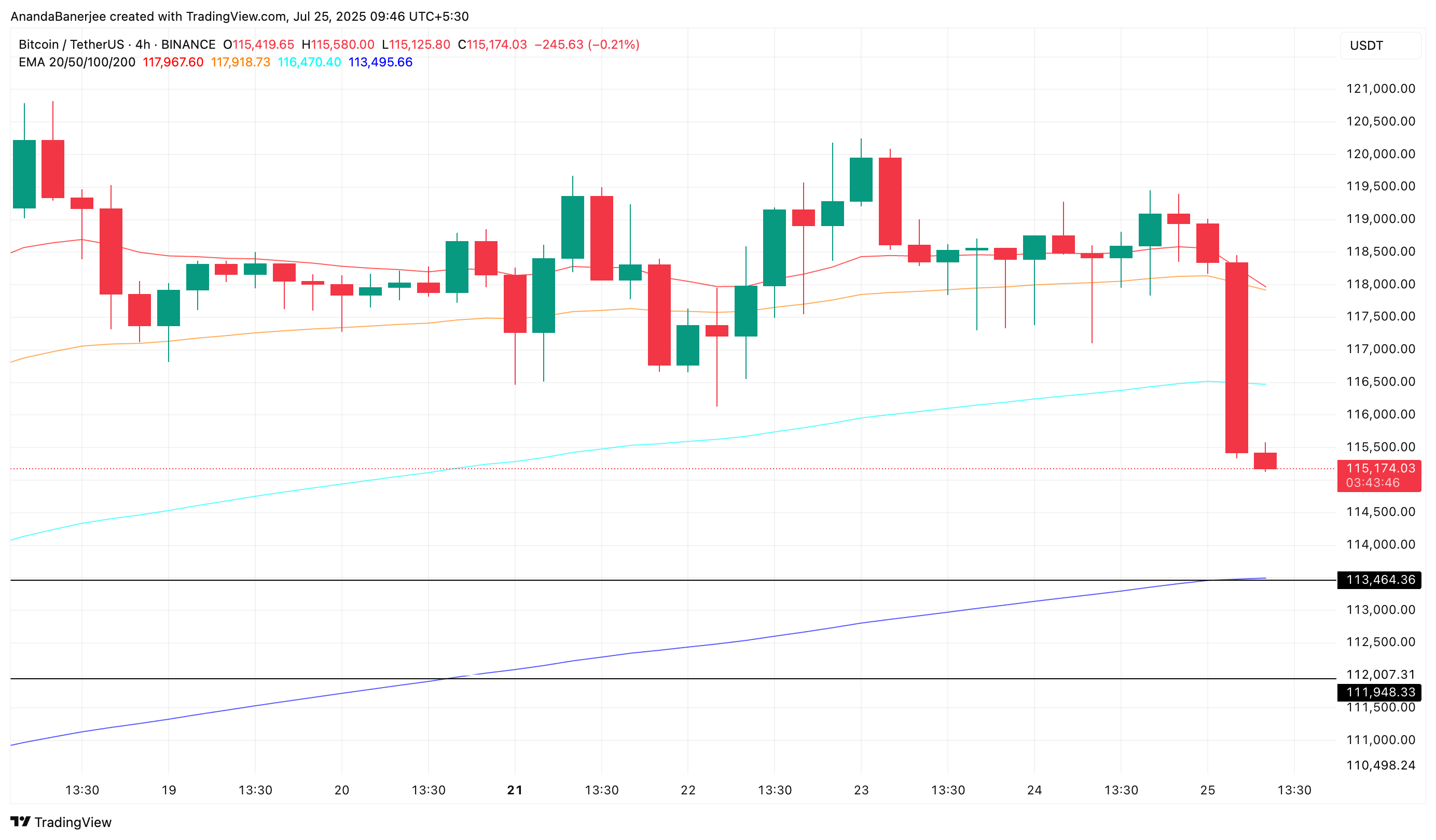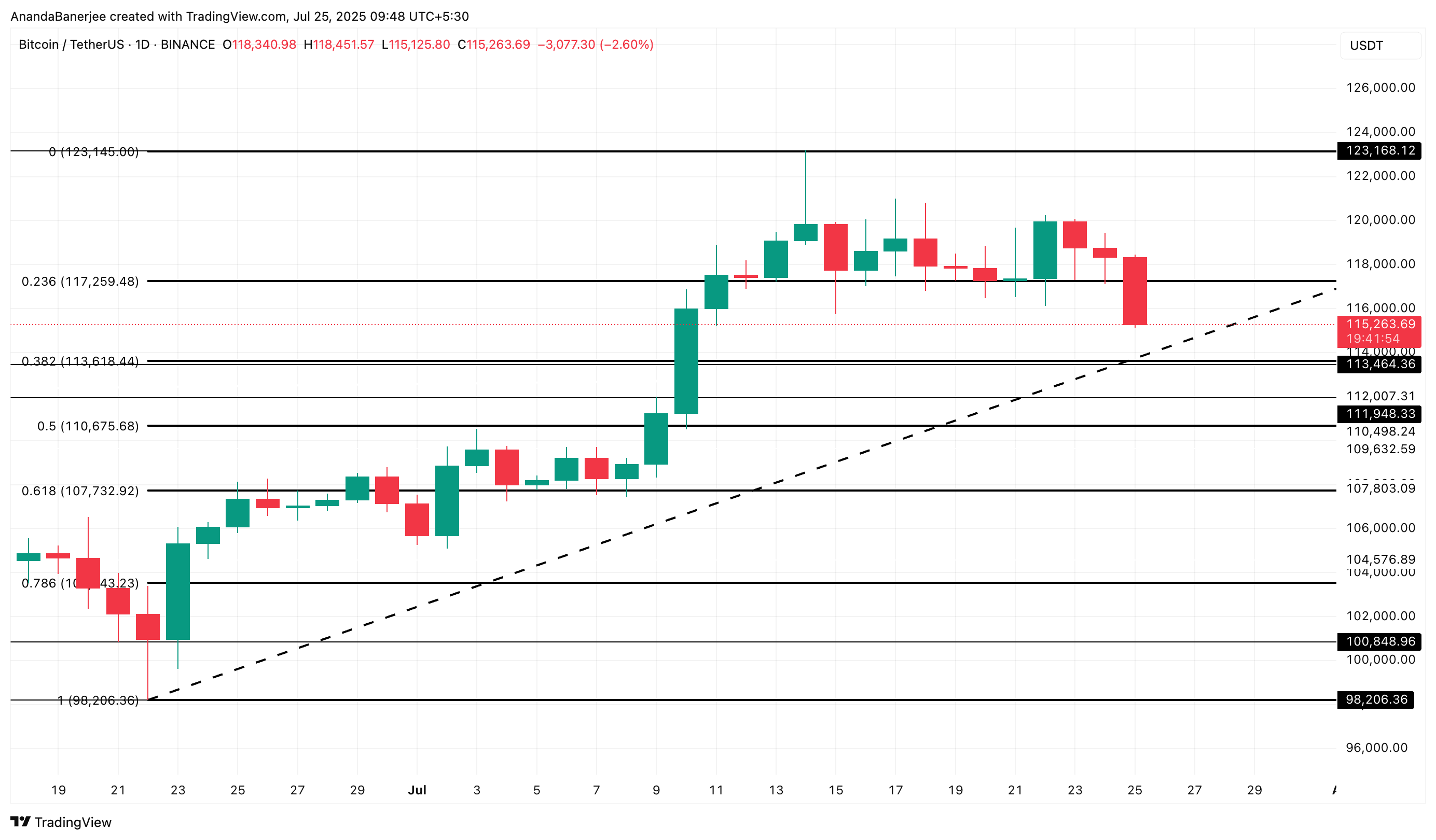-
Bitcoin whale addresses have decreased by 2.7% over the past 10 days, indicating a notable withdrawal by major holders amid rising market uncertainty.
-
The exchange whale ratio has surged, signaling increased movement of large Bitcoin holdings to exchanges, a trend often interpreted as a precursor to selling pressure.
-
According to COINOTAG, Bitcoin’s price recently fell below the 100 EMA on the 4-hour chart, with a bearish crossover looming and $113,000 identified as a critical support level.
Bitcoin whale activity declines and bearish EMA signals suggest potential price correction, with $113,000 as key support amid rising exchange inflows.
Declining Whale Addresses Signal Potential Market Weakness
Bitcoin’s recent price action, down approximately 6% from its all-time high near $123,000, coincides with a significant reduction in whale activity. The number of addresses holding between 1,000 and 10,000 BTC dropped from 2,037 to 1,982 over 10 days, marking the steepest decline in over half a year.
This contraction in whale participation often reflects a shift in market sentiment among large holders, potentially foreshadowing increased volatility. Whale behavior is a critical indicator because these holders can influence market dynamics through large-scale transactions.

Bitcoin price and whale address count: Glassnode
Simultaneously, the exchange whale ratio—a metric measuring the proportion of whale inflows to exchanges—has reversed its previous downtrend. After making three consecutive lower highs in early July, the ratio increased from 0.5 on July 22 to 0.52 by July 24, coinciding with the initial price dip.
This uptick suggests that whales are actively transferring Bitcoin to exchanges, typically a precursor to selling. Historical patterns reinforce this interpretation, as rising exchange inflows from whales often precede downward price movements.

Bitcoin price and Exchange whale ratio: Cryptoquant
Adding to institutional signals, Galaxy Digital’s recent deposit of over 10,000 BTC to exchanges highlights growing caution among prominent market participants.
Note that #GalaxyDigital has deposited over 10,000 $BTC($1.18B) to exchanges in the past 8 hours!
The 10,000+ $BTC comes from the Bitcoin OG holding 80,009 $BTC($9.68B).https://t.co/qaSj0NKwmD pic.twitter.com/09XEqB6VGg
— Lookonchain (@lookonchain) July 25, 2025
Bearish EMA Indicators Point Toward Potential Breakdown
Technical analysis on the 4-hour BTC chart reveals a bearish setup reinforcing the on-chain signals. The price recently fell below the 100-period exponential moving average (EMA), a critical short-term support level.
Moreover, the 20-period EMA is poised to cross below the 50-period EMA, forming a classic bearish “death” crossover. This technical formation is widely regarded as a signal that sellers are gaining momentum in the short term.

A bearish crossover waiting to happen: TradingView
Such EMA crossovers often trigger increased selling activity as traders adjust positions based on momentum shifts. This aligns with the observed whale outflows and institutional movements, suggesting a coordinated market response.
The next significant support level is the 200-period EMA on the 4-hour chart, currently near $113,000. This level is critical as it coincides with broader market support zones, potentially serving as a last line of defense against further declines.
Key Support Levels Highlight $113,000 as Critical Threshold
Examining the daily Bitcoin price chart reveals a consolidation phase near $117,000, which recently gave way to a sharp decline toward $115,000. If the $113,000 support fails to hold, the price may test lower Fibonacci retracement levels at $110,000 and $107,000, corresponding to the 0.5 and 0.618 retracements respectively.

Bitcoin price analysis: TradingView
These Fibonacci levels are not arbitrary; they reflect collective trader psychology and often act as natural support during pullbacks. A breach below $113,000 could intensify selling pressure, potentially leading to a deeper correction.
Conversely, reclaiming $117,000 and pushing toward the previous all-time high near $123,000 would signal renewed bullish momentum. However, such a recovery likely requires renewed confidence from major holders and institutional players.
Conclusion
Recent on-chain data and technical indicators collectively point to a cautious outlook for Bitcoin. The decline in whale addresses, rising exchange inflows from large holders, and bearish EMA crossovers suggest mounting selling pressure. The $113,000 level emerges as a pivotal support that could determine Bitcoin’s near-term trajectory. Market participants should monitor these signals closely, as a sustained break below this threshold may lead to further downside, while a rebound could restore bullish sentiment. Staying informed and responsive to these developments remains essential for navigating the evolving Bitcoin landscape.
